I have a Firstwatt F1 amplifier that I bought at an estate sale not too long ago. It has mostly sounded great on a pair of full range speakers, but there is an behavior that I've noticed repeatedly that may need some attention. When I first power-on the amp for a listening session, I hear scratchy static noise on only one channel which lasts for 20-30 seconds. The noise is similar to what you might hear with loose speaker wires. (It's not the speaker wires... I've triple checked for bad external connections.) It doesn't seem to happen again as long as the amp remains powered up. If I perform a quick power cycle after the amp has been on for a while (and warm) the noise does not reoccur. It appears that the amp needs to be off for some time before I can reproduce the issue. (Perhaps providing enough time for the heatsinks to cool down and/or capacitors to discharge...?)
Could this point to aging capacitors that need replacement? Would anyone have any suggestions for how to track down the source of this noise?
Could this point to aging capacitors that need replacement? Would anyone have any suggestions for how to track down the source of this noise?
The big electrolytic caps in the power supply may be due for replacement. There might not be any visible signs of degradation. Check the voltage rating of these devices once you have the lid removed.
I had an older Naim power amp with this symptom. It just needed to be recapped.
I had an older Naim power amp with this symptom. It just needed to be recapped.
Alright... I opened up the lid tonight to take some photos. (See attachments) I didn't see any obvious signs of damage to the electrolytic caps. There is an oddity with one of the caps in the PS that you can see in the photos. The wrapping which surrounds the can doesn't reach the top like all the other caps, and it is missing its plastic hat. The plastic hat appears to be wedged below two adjacent electrolytic caps and it is even touching the leads to the green caps connected to the transformer leads. (I can't find these two smaller caps on the power supply schematic, by the way.) I wonder if this displaced plastic hat could be causing the problem. It should be easy to remove and retest... I just haven't done it yet.
Beyond the plastic hat mentioned above, does anyone have suggestions for further investigation? I could pull caps and try testing them...
One happy surprise: It looks like a previous owner has already upgraded this unit to an F1J. I was thinking of doing this myself prior to taking a close look inside. I understand the SJEP120R100 JFETs are hard to come by, so I'm really pleased to know that I don't need to pay a fortune on ebay for these JFETs now.
Beyond the plastic hat mentioned above, does anyone have suggestions for further investigation? I could pull caps and try testing them...
One happy surprise: It looks like a previous owner has already upgraded this unit to an F1J. I was thinking of doing this myself prior to taking a close look inside. I understand the SJEP120R100 JFETs are hard to come by, so I'm really pleased to know that I don't need to pay a fortune on ebay for these JFETs now.
Attachments
-
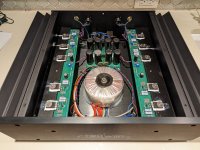 PXL_20230224_044710471.jpg498.1 KB · Views: 106
PXL_20230224_044710471.jpg498.1 KB · Views: 106 -
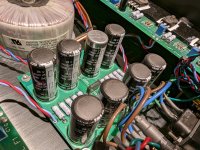 PXL_20230224_044026087.jpg728.2 KB · Views: 102
PXL_20230224_044026087.jpg728.2 KB · Views: 102 -
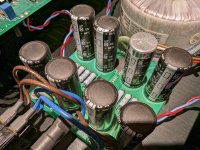 PXL_20230224_044049681.jpg714 KB · Views: 100
PXL_20230224_044049681.jpg714 KB · Views: 100 -
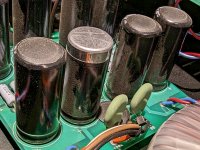 PXL_20230224_044232182.jpg607.3 KB · Views: 98
PXL_20230224_044232182.jpg607.3 KB · Views: 98 -
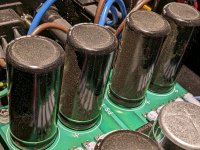 PXL_20230224_044242597.jpg651 KB · Views: 96
PXL_20230224_044242597.jpg651 KB · Views: 96 -
 PXL_20230224_044834727.jpg387 KB · Views: 99
PXL_20230224_044834727.jpg387 KB · Views: 99 -
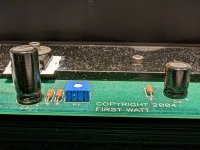 PXL_20230224_044323683.jpg513.7 KB · Views: 92
PXL_20230224_044323683.jpg513.7 KB · Views: 92 -
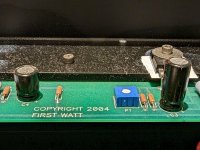 PXL_20230224_044404059.jpg502.8 KB · Views: 92
PXL_20230224_044404059.jpg502.8 KB · Views: 92 -
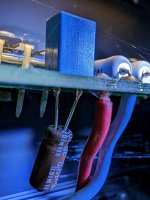 PXL_20230224_045733936.jpg430.5 KB · Views: 89
PXL_20230224_045733936.jpg430.5 KB · Views: 89 -
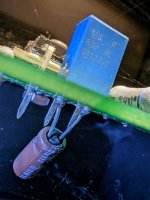 PXL_20230224_045807307.jpg429.4 KB · Views: 100
PXL_20230224_045807307.jpg429.4 KB · Views: 100 -
 PXL_20230224_045914322.MP.jpg335.1 KB · Views: 94
PXL_20230224_045914322.MP.jpg335.1 KB · Views: 94 -
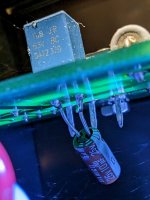 PXL_20230224_045951332.MP.jpg338.2 KB · Views: 93
PXL_20230224_045951332.MP.jpg338.2 KB · Views: 93 -
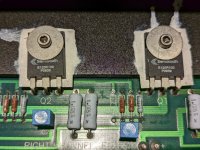 PXL_20230224_044154155.jpg747.4 KB · Views: 111
PXL_20230224_044154155.jpg747.4 KB · Views: 111 -
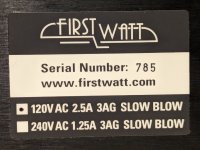 PXL_20230224_044920636.jpg351.4 KB · Views: 99
PXL_20230224_044920636.jpg351.4 KB · Views: 99
Those shrink wrap sleeves seem to continue to shrink with heat. Still the noise should be checked out. You can call the factory and talk to Kent. Not today, he's still at the Florida show...
@lsoasey An F1J at an estate sale! Some folks have all the luck 😎 a hearty and envious congratulations to you! It took me several years to find my F1, which was never upgraded. I like mine enough that I’m afraid to change it, and R100s ain’t cheap.
The sleeves also shrank on the PS caps in my F1 and a few of the plastic discs were floating around inside, but I don’t have any noise issues. In your pictures one cap seems to have shrunken the sleeve more than the others which could indicate it got hotter than the others (possibly more leakage current?). Pass labs repair costs were surprisingly low the one time I called to get an idea of the cost before buying an used amplifier.
The sleeves also shrank on the PS caps in my F1 and a few of the plastic discs were floating around inside, but I don’t have any noise issues. In your pictures one cap seems to have shrunken the sleeve more than the others which could indicate it got hotter than the others (possibly more leakage current?). Pass labs repair costs were surprisingly low the one time I called to get an idea of the cost before buying an used amplifier.
Thanks for the reply, Mr. Pass. I appreciate your involvement and contributions here! I'll try reaching out to Kent once he is back.
@olen -- I definitely admit that this was a lucky estate sale find. It was a photograph of the full range horn speakers that caught my attention. I didn't know anything about the Firstwatt F1 amp when I first decided to pursue the speakers. The whole package ended up also coming with a working Resolution Audio Opus 21 CD/SACD player and a Zoethecus 5-level rack. This was probably my once-in-a-lifetime lucky find since the price I paid was only a fraction of of the value of any one of the components in the set. It's your turn next for a lucky find. 🙂
Interesting thought on the possibility of the cap with the shrunken sleeve potentially getting hotter than the others. Perhaps that's where I should start with some testing. Would you or others know if it's feasible to identify a bad cap through bench testing after it is removed from the board? (I assume it is, I just haven't spent the time do this in the past...) I don't own an LCR meter yet, but I was already thinking about picking one up do to other DIY work that I'm planning to dive into. I do have a multiple DMMs and a digital scope at the moment.
@olen -- I definitely admit that this was a lucky estate sale find. It was a photograph of the full range horn speakers that caught my attention. I didn't know anything about the Firstwatt F1 amp when I first decided to pursue the speakers. The whole package ended up also coming with a working Resolution Audio Opus 21 CD/SACD player and a Zoethecus 5-level rack. This was probably my once-in-a-lifetime lucky find since the price I paid was only a fraction of of the value of any one of the components in the set. It's your turn next for a lucky find. 🙂
Interesting thought on the possibility of the cap with the shrunken sleeve potentially getting hotter than the others. Perhaps that's where I should start with some testing. Would you or others know if it's feasible to identify a bad cap through bench testing after it is removed from the board? (I assume it is, I just haven't spent the time do this in the past...) I don't own an LCR meter yet, but I was already thinking about picking one up do to other DIY work that I'm planning to dive into. I do have a multiple DMMs and a digital scope at the moment.
no need to test those caps - just replace all electrolytic caps in amp .......... when you see something as that, it is obvious that amp had years of hard life, thermally - most likely without sufficient space around
caps - they're cheap and available
Pa did advice you to contact Kent, so best to wait for that - it can happen that you have your amp repaired without too much brain activity
it's very well worth it
caps - they're cheap and available
Pa did advice you to contact Kent, so best to wait for that - it can happen that you have your amp repaired without too much brain activity
it's very well worth it
Here is the article on the F1J for anyone interested. It is really neat that Mr. Pass circles back to some of these old designs and gives them an update:
https://www.firstwatt.com/f1j.html
https://www.firstwatt.com/f1j.html
in any case, there is still some choice of good brand snap-in caps at mou or digi
other places too
choice even bigger if you see that you can squeeze snap-ins with 35mm Dia
15mf to 33mF will do, 25Vdc
small ones are even less critical, and even Silmics are not hard to find - use 10uF to 22uF for those
re-check all solder connections, if some suspicious - clean it (suck) and solder again
re-check torque of all semis ( not doubting Pa, that in case someone else put hands in after)
pretty straightforward work, parts hardly above 100 greenies ........ and these amps will worth more with time, for certain
when done, make nice Babysitter for Summer months and you'll be happy camper for 2 decades at least
other places too
choice even bigger if you see that you can squeeze snap-ins with 35mm Dia
15mf to 33mF will do, 25Vdc
small ones are even less critical, and even Silmics are not hard to find - use 10uF to 22uF for those
re-check all solder connections, if some suspicious - clean it (suck) and solder again
re-check torque of all semis ( not doubting Pa, that in case someone else put hands in after)
pretty straightforward work, parts hardly above 100 greenies ........ and these amps will worth more with time, for certain
when done, make nice Babysitter for Summer months and you'll be happy camper for 2 decades at least
I have to agree with ZM about calling Kent at Pass Labs about getting it repaired. PL only charges for parts and labor to repair, with their actual cost for parts (probably lower than buying from DigiKey or Mouser yourself). With their very reasonable labor rate (they will tell you how much up front) they aren’t making money on repairs - they’re doing it to support their customers and because they stand behind their products even when they’re over 20 years old.
- Home
- Amplifiers
- Pass Labs
- Firstwatt F1 makes temporary static noise on power up
